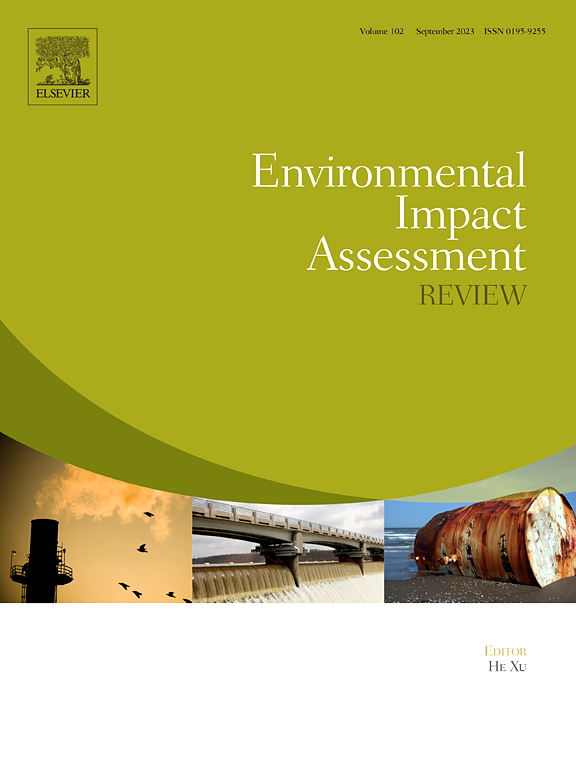Projecting cropland climatic potential productivity change in China under human activity and climate force
IF 9.8
1区 社会学
Q1 ENVIRONMENTAL STUDIES
引用次数: 0
Abstract
Human activity and climate change threaten agricultural production, making it crucial to understand their impacts on cropland potential productivity (CLPP). Our study examines cropland climatic potential productivity (CLCPP), a climate-specific derivative of CLPP that represents the maximum crop yield achievable under optimal non-climatic conditions but constrained by climate. The respective impacts of future climate change and cropland use change (CLUC) on CLCPP remain inadequately studied. Using a newly produced scenario-based CLUC dataset and Shared Socioeconomic Pathways and Representative Concentration Pathways (SSP-RCP) climate projections, we assessed the CLCPP variation and their relative contributions in China during 2020–2100. Results show that the total CLCPP in China will increase from 771 million tons (Mt) in 2020 to 871–1744 Mt. in 2100, except under the uneven regional development scenario (i.e., the SSP3-RCP7.0 scenario). Climate change will increase the total CLCPP by 10.10 % ∼ 91.11 % under the medium- and high-emission scenarios and decrease the total CLCPP under the low-emission scenarios. CLUC will mitigate the negative impact of climate change on the total CLCPP under low-emission scenarios, thereby increasing it by 12.89 % ∼ 56.71 % under comprehensive conditions (i.e., both climate change and CLUC). Spatially, the area with a high contribution (>50 %) of climate change to the CLCPP variation will cover 35.58 % to 48.02 % of the total cropland area, while the ratio with a low contribution (≤2 %) of the CLUC will cover 45.84 % ∼ 56.94 %. Climate change has more substantial impact on CLCPP variation than that CLUC. Our findings suggest that the medium-emission scenario (i.e., the SSP2-RCP4.5 scenario) is the priority pathway for increasing China's CLCPP.
人类活动和气候力作用下中国耕地气候生产力潜力变化预测
人类活动和气候变化威胁着农业生产,因此了解它们对耕地潜在生产力(CLPP)的影响至关重要。我们的研究考察了耕地气候潜在生产力(CLCPP), CLCPP是CLPP的气候特异性衍生物,代表了在最佳非气候条件下但受气候限制的最大作物产量。未来气候变化和耕地利用变化对CLCPP的影响研究尚不充分。利用新生成的基于情景的CLCPP数据集和共享社会经济路径和代表性浓度路径(SSP-RCP)气候预测,我们评估了2020-2100年中国CLCPP的变化及其相对贡献。结果表明:除区域发展不均衡情景(即SSP3-RCP7.0情景)外,中国CLCPP总量将从2020年的7.71亿吨增加到2100年的871-1744亿吨;在中、高排放情景下,气候变化将使总CLCPP增加10.10% ~ 91.11%,而在低排放情景下,将使总CLCPP减少。在低排放情景下,CLUC将减轻气候变化对总CLCPP的负面影响,从而在综合条件下(即气候变化和CLUC)增加12.89% ~ 56.71%。在空间上,气候变化对CLCPP变化的高贡献区(50%)占总耕地面积的35.58% ~ 48.02%,而低贡献区(≤2%)占总耕地面积的45.84% ~ 56.94%。气候变化对CLCPP变化的影响比CLCPP变化的影响更大。研究结果表明,中等排放情景(即SSP2-RCP4.5情景)是提高中国CLCPP的优先途径。
本文章由计算机程序翻译,如有差异,请以英文原文为准。
求助全文
约1分钟内获得全文
求助全文
来源期刊

Environmental Impact Assessment Review
ENVIRONMENTAL STUDIES-
CiteScore
12.60
自引率
10.10%
发文量
200
审稿时长
33 days
期刊介绍:
Environmental Impact Assessment Review is an interdisciplinary journal that serves a global audience of practitioners, policymakers, and academics involved in assessing the environmental impact of policies, projects, processes, and products. The journal focuses on innovative theory and practice in environmental impact assessment (EIA). Papers are expected to present innovative ideas, be topical, and coherent. The journal emphasizes concepts, methods, techniques, approaches, and systems related to EIA theory and practice.
 求助内容:
求助内容: 应助结果提醒方式:
应助结果提醒方式:


